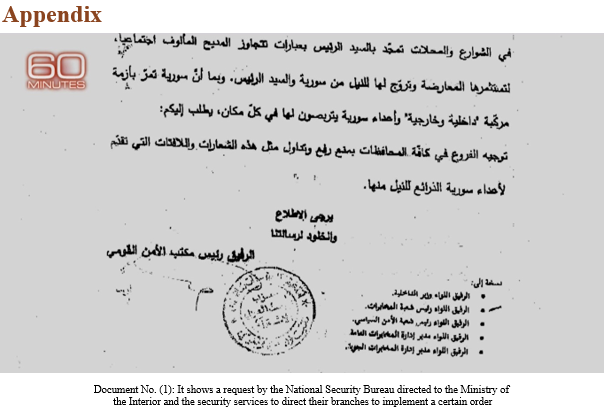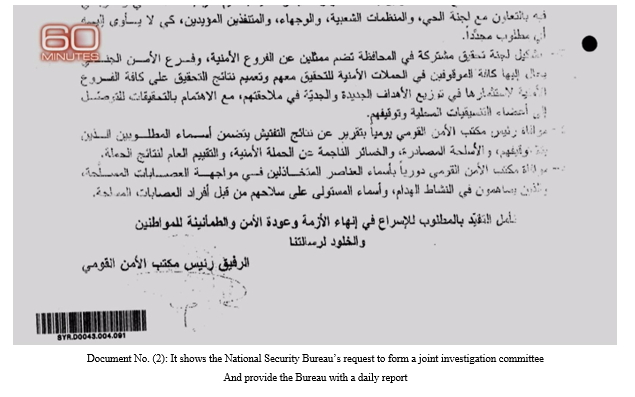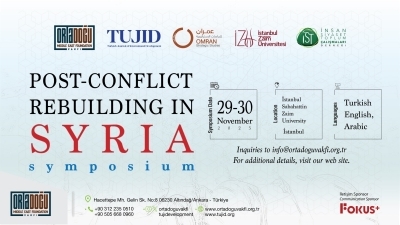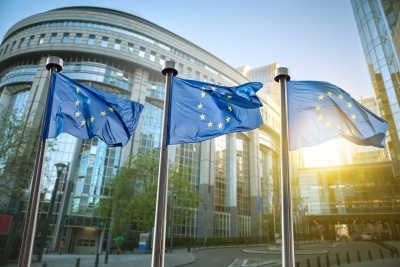Executive Summary
- This paper provides an illustrative overview and assessment of the chain of command inside the Syrian Military and Armed Forces, while also noting the impact of both formal and informal tracks. It also explains the impact of the regime’s allies intervention in military decision making.
- Interactive figures visualize the decision-making lines within the chain of command, illustrating who occupies the most critical positions in the army, security services, and the Syrian Ministry of Interior. It also presents identification cards of the most influential leaders within that chain.
- Military and security decision-making within the regime’s structures is an ambiguous and complex process. All powers belong to the “President of the Republic,” yet the structure consolidates elements of sectarian fanaticism, security arrangements and façade, and allies’ military interventions in appointments, structures and roles.
- The regime’s complex nature allows for familial and sectarian fanaticism to intervene with the security structure. This has allowed for the bypassing the formal chain of command and the bureaucratic mechanism. The flow of commands then favors many loyalties and those connected.
- The military intervention of the regime’s allies, particularly Russia and Iran, has impacted the Syrian military and security’s chain of command. The regime’s allies have been able to influence decision making through formal tracks and unofficial networks.
- The chain of command within the Syrian armed forces are divided into several levels, starting with the Commander in Chief, the Minister of Defense, the National Security Bureau, Intelligence, the Ministry of Interior, and then the military units.
- Despite the growing Iranian and Russian influence on the military and security institutions, Bashar al-Assad, as the “President of the Republic and Supreme Commander of the Army and Armed Forces,” still formally controls the chain of command and the flow of orders.
- The Chief of Staff position has been vacant since 2018, which is a precedent that the Syrian army has not witnessed since its establishment. This vacancy raises questions on the impact of an allies intervention and overruling over the chain of command within Syrian military institutions.
Introduction
When Syria’s popular protests sparked in 2011, the Syrian regime quickly used the military to suppress demonstrations initially and then confront the armed opposition fighters. This prolonged the military conflict and directly impacted the human resources of many military units. Military units suffered from defections, escape, non-joining, and the killing, wounding, and capturing of many soldiers. As a result of the successive military operations by opposition fighters in the early years of the revolution, the army also struggled on a logistical level, with equipment and its headquarters became strained. The military units were also affected by the redeployment operations carried out by the regime. The redeployment operations re-organized the regime’s military units, moving them from their original base location to other districts within Syria. This prompted the establishment of new formations by including units of different subordination within a new military body or unit.
On the other hand, the regime’s allies, Russia and Iran, were able to influence the general structure of the army and armed forces to varying degrees after their direct military intervention. For example, Iran formed militias outside the military structure and later incorporated relatively small local militias within military divisions giving Iran military influence within the ranks of the Syrian military. On the other hand, the Russian intervention had a more significant and more profound impact. Moscow supervised the training, armament, and development of military plans for most army units and formations, restructured some military units, and founded new military formations that are linked to Russia directly.
The mentionedchanges led to transformation in the army’s structure and power nodes, directly affecting the chain of command and the military hierarchy for orders within official or unofficial networks.
This paper seeks to shed light on the chain of command and decision making flow within official and unofficial networks, with a focus on the regime’s allies influence on the Syrian military institution as a whole. The “interactive figure” illustrates the path of commands through the Syrian military structure within theessential positions in the army, security services, and the interior ministry. The “interactive figure” also provides identification cards for the leaders of these units, and uncovers the subordination of each unit within the chain of command and orders.
Supreme Commander of the Army and Armed Forces
As “President of the Republic and Supreme Commander of the Army and Armed Forces” per Article /105/ of the 2012 Constitution, Bashar al-Assad is the anchor point, the beginning of the chain of command, and the source of official orders. The Minister of Defense, General Ali Abdullah Ayoub, the Head of the National Security Bureau, Major General Ali Mamlouk, and the Minister of Interior, Major General Muhammad Rahmoun, are linked to him directly.
All appointments and promotions of commanders, directors, chiefs, and officers of all army and armed forces units, including the security services, are carried out through decrees and decisions issued personally by Bashar al-Assad. This happens at two levels: first, a routine bureaucratic level represented in issuing periodic promotions, transfers, and appointments according to the chain of command and official orders, and by consulting the National Security Bureau and the intelligence services, each according to its competence without any interference by the civil state agencies and institutions. The second level is through managing the equilibriums of the relationship with the regime’s allies and making appointments that take these relationships into account.
Although the decision-making mechanisms and hierarchy are clearly outlined, they are not binding for Assad to follow. He exceeds the issuing orders of any party, assisted by a broad power afforded to him by the constitution and laws regulating the army’s work. Additionally, the complex nature and structure of the regime (security, family, and sectarian considerations) often makes the decision-making mechanism a highly ambiguous process.
National Security Bureau and Intelligence Services
The National Security Bureau, headed by Major General Ali Mamlouk since July 2012, serves as the primary hub that links, supervises, coordinates, and directs the work of security.The Bureau holds a critical advisory role to Bashar al-Assad in all issues related to national security, negotiations, and other internal and external security affairs. Four main security agencies operate under its advisory with their various subordination; the Military Intelligence Division, Air Force Intelligence Department, General Intelligence Directorate, and Political Security Division.
The Military Intelligence Division reports directly to the General Staff, while the Air Force Intelligence Department belongs administratively to the Air Force and Air Defense Command. These two agencies are the largest and most powerful intelligence agencies that belong “officially” to the Ministry of Defense. On the other hand, the General Intelligence Directorate, also known as “State Security,” reports directly to the President of the Republic. The General Intelligence Directorate coordinates directly with the National Security Bureau. In terms of the Political Security Division, it belongs administratively to the Ministry of Interior. Nevertheless, the Minister of Interior does not have any actual powers over the Political Security Division’s work, and only coordinates its administrative and logistical aspects. Instead, the Political Security Division is the one that monitors the entire Ministry of Interior, starting with the Minister of Interior and ending with the ministry’s most minor elements.
The heads of the four security agencies and their branches are appointed personally by the President of the Republic, without any interference by the civil state institutions or even informing them. The commanders of the Military and Air Intelligence agencies must be from the army’s ranks. As for the leaders of the General Intelligence and Political Security agencies, some of them may be secondment to the Ministry of Defense or the Ministry of Interior, in order to work in these agencies, which applies to all officers working in the intelligence services.
Currently, major generals that lead these four offices are; Kifah Melhem, Head of the Military Intelligence Division, Ghassan Ismail, Head of the Air Force Intelligence Department; Hussam Louka, Head of the General Intelligence Directorate; and Ghaith Deeb, Head of the Political Security Division. All of them are Military College graduates. Since their establishment in the 1970s (in their current form), the Military and Air Intelligence Agencies have been headed by officers from the Alawite sect, while officers in the General Intelligence and Political Security may be from other sects.
Ministry of Defense
Since the beginning of 2018, the Ministry of Defense has been led by General Ali Abdullah Ayoub, a successor to General Fahd Jassim Al-Freij. The Minister of Defense is appointed by the President of the Republic and Commander-in-Chief of the Army and Armed Forces. The prime minister never interferes in this process. The Minister of Defense holds the position of Deputy Commander-in-Chief of the Army and Armed Forces, as a Deputy Prime Minister, and a member of the Central Command and the Central Committee of the ruling Baath Party. The Ministry of Defense mainly supervises the General Staff and several offices and departments affiliated with it. It also coordinates with the ministries and state institutions on the affairs of the army and the armed forces in the aspects that require coordination.
General Staff
The Chief of the General Staff of the Army and Armed Forces is usually occupied by the rank “General” and is appointed by the President of the Republic and Commander-in-Chief of the Army and Armed Forces. The Chief of Staff is also treated as a minister by the Military Service Law of 2003 and its amendments. He is the officer who controls the Ministry of Defense at a later time. This is a common trend, as all defense ministers since 1967 served as chiefs of the General Staff, before pursuing Minister of Defense.
Since July 2012, General Ali Ayoub had held the position of Chief of Staff, but was later named Minister of Defense at the beginning of 2018. Since then, the position of Chief of Staff has remained vacant. This is an extraordinary situation that the Syrian army has not witnessed since its establishment in 1946,which raises many questions about how military operations are managed throughout the country during a “war.” Currently a chief of staff is not present to manage those operations. Sources indicate that the Russians (and Iranians) have assumed tasks related to the chief of staff in military operations through the Russian operations room located in Damascus (in the headquarters of the General Staff).The Minister of Defense assumes the administrative tasks of the Chief of Staff. The vacancy of this sensitive position during the existing circumstance indicates a significant defect in the chain of command and orders. However, the interference of the regime’s allies in this position outlines the impact they have on the chain and the depth of their intervention. Their interferences may be breaking the centralization and bureaucracy of the regime’s military decision making, swaying decisions in their favor. The chief of staff is the central position of the “Army and Armed Forces,” and it supervises and commands all corps, divisions, and combat units, as well as a large number of departments and divisions.
Corps, Divisions, and Military Units
All military corps, divisions, and units within the chain of command and orders report to the Chief of the General Staff. The “interactive figure” shows how the five military corps and the divisions affiliated with them are distributed. Additionally, the military divisions, bodies, and departments report directly to the General Staff without subordination to any corps.
All corps, divisions, and departments - except for the 18th Division - are currently led by Alawite sect officers from four governorates (Latakia, Tartous, Homs, and Hama). The position of the corps commander is almost a formal administrative position, while the division commander has more power due to his direct command of the combat military unit, and this power varies according to the division’s number and the nature of its military tasks.
From another perspective, these units still maintain their party formation and are linked to the ruling Baath Party until now, including branches, divisions, and party cells. The military personnel are still generally prevented from affiliating politically with anything other than the Baath Party, despite the abolition of Article 8 of the Constitution.
On the other hand, both the Iranian and Russian military interventions influenced the military units and their leaders and officers. Russia had the most significant and powerful influence on a large number of units such as the Fifth Corps, the Republican Guard, the 17th Division, the 25th Division, the Air Force Command, and Air Defense.Furthermore, the Russian military advisors have penetrated all military units from divisions to battalions. Unlike Russia, Iran is satisfied with good relations with some commanders and officers of specific units due to some interests with the commanders of these units, such as Fourth Division, Fourth Corps, and Ninth Division) and some branches of the intelligence agencies.
Conclusion
After 2011, it is apparent that the Syrian army’s chain of command and orders has been greatly affected by several factors and variables. The most significant being the regime allies’ intervention in the military and its growing impact. The foreign interventions are primarily connected to Russia’s influence, more than Iran, as Russia is involved in the official circles of influence and informal networks. Sometimes Russia influences by bypassing outlined decision-makers in the chain of command, breaking the traditional centralized decision making mechanisms. This has illustrated the regime’s inability to control all military units effectively.
Despite the growing Iranian and Russian influence on the military and security institutions, Bashar al-Assad, as the “President of the Republic and Supreme Commander of the Army and Armed Forces,” still formally controls the chain of command and orders.However, this formal control does not imply complete control over appointments and the flow of orders. These may be influenced by regime’s allies according to their respective balance of interests and needs.
Bashar al-Assad has taken steps to reduce the influence of his allies on the military establishment, attempting to show a centralized chain of command. Before Russia’s intervention, this was the situation and was showcased through periodic military appointments that tried to mitigate the impact of interconnected networks. Chiefs of Intelligence agencies enjoy relative stability due to the unique nature of the work entrusted to them and the difficulty of assigning these positions to all officers. On the other hand, the promotions and appointments processes are still executed in a non-professional manner. The decisions are governed by loyalty, which above all, is linked to sectarian fanaticism that continues to penetrate the army from top to bottom.
Despite all its complexities and mixed dynamics, the military chain of command is a critical component of the Syrian regime. As the anchor point and head of the command, Bashar al-Assad assumes direct responsibility for the decisions made after 2011, including violations committed by the army and security services against civilians, documented massacres, and the use of internationally prohibited weapons including chemical weapons.





